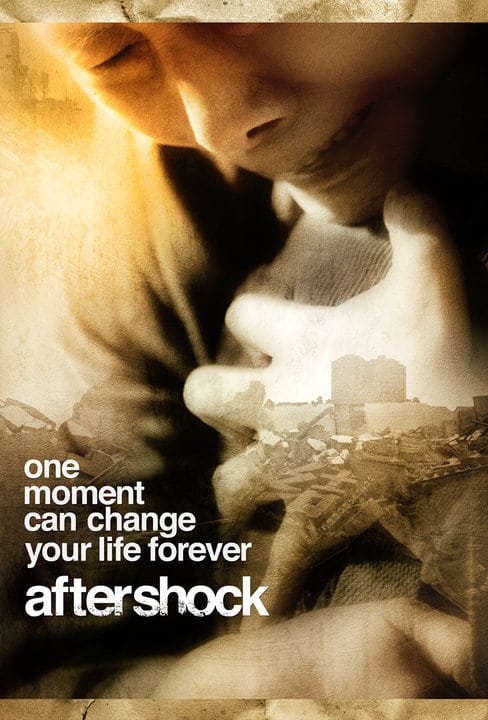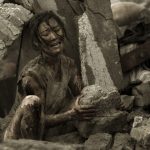C’est le 28 juillet prochain que va être disponible en Chine le nouveau film en IMAX de Feng Xiaogang, sur le tremblement de terre de Tangshan en 1976. une mère a le choix entre sauver sa fille ou son fils. Les deux enfants survivront. Devenus orphelins, leur destin sera profondément marqué par cette expérience…
A la fin de l’article une interview en anglais. Pour en savoir plus sur cette tragédie la page wikipedia est là.
Filmé au format IMAX, le film au budget de 150 millions de Yuan à pour objectif les 500 millions. Coproduit par China Film, Huayi Bros et Emperor Group, le réalisateur à réussi à obtenir une subvention de 60 millions de Yuan de la part de la municipalité de Tangshan. On retrouve au casting, Zhang Jingchu, Chen Daoming, Chen Jin, Xu Fan, Lu Yi, Li Chen, Pan Hong. Élément important, les acteurs ont travaillé pour un salaire symbolique.
Interview:
http://www.hollywoodreporter.com/hr/content_display/asia/news/e3id06d4e1f127671ac4bb67e6b11db901a
ou disponible ici:
IMAX CEO talks about Feng Xiaogang’s ‘Aftershock’
By Jonathan Landreth
June 18, 2010, 03:58 AM ET
Rich Gelfond
IMAX CEO Rich Gelfond. (Getty)
SHANGHAI — Rich Gelfond, CEO of giant-screen theater company IMAX, treated the Texas delegation to the USA Pavilion at the World Expo 2010 and hundreds of their Chinese guests to a screening of “Hubble 3D” on the sidelines of the 13th Shanghai International Film Festival this week.
Cautioning viewers gathered at the New York-based company’s first commercial theater in China, the Peace Cinema in Shanghai’s People’s Square, built in 2004, Gelfond reflected on the brilliant four-story images of the depths of the known universe captured by NASA’s giant orbiting telescope: “You’ve seen ‘Star Wars,’ and you’ve seen ‘Star Trek,’ but remember, these images are real.” It is with that same sense of awe at the possibilities of the frontier that Gelfond described to The Hollywood Reporter’s Jonathan Landreth IMAX’s growing business in China.
The Hollywood Reporter (THR) : How much of IMAX’s business is going to come from China in the coming years?
Rich Gelfond (RG): Over the short term, there’s really nowhere in the world that is as active as China right now. “Avatar” and “Alice in Wonderland” were a little bit of a tipping point in this area of the world. We had done well in this region but I think that “Avatar” brought in new consumers for the first time that had never seen IMAX before and I think they liked what they saw. They saw trailers for a lot of new movies and I think that really established our brand in a big way here.
The exhibitors’ financial model was challenged by the recent successes of “Avatar” and “Alice,” which made very good returns. At the same time, there is this huge screen growth going on in China with lots of new multiplexes going up with help from real estate developers and the government’s moving control [of theaters] from the cultural ministry to the commerce ministry. I think the combination of these factors — the increased popularity of IMAX as well as the focus on building up the multiplex infrastructure — has really created ideal conditions for growth here.
THR: Can you give us specific numbers?
RG: We have 23 theaters open in China today, and there will be more in a few days. We will have over 50 by 2012, and those are all signed, they just haven’t opened yet but are being constructed. At the time of director Feng Xiaogang’s “Aftershock,” which is in mid-July, there are two more IMAX screens opening in Shanghai, and then there are two more coming in Hangzhou. That’s why we say 23 now but 27 in a month. If you include Hong Kong and Taiwan, we have 33 theaters open in Chinese-speaking territories today and, by 2012, hat number will be over 70.
THR: Feng’s « Aftershock, » a drama about the 1976 Tangshan earthquake that killed 300,000 people, is the first of three pictures IMAX agreed last year at the Shanghai International Film Festival to make with China’s first publicly-listed movie studio, Huayi Brothers Media. It is the first IMAX picture made outside of the United States. What will the other pictures be?
RG: I actually have meetings with Huayi later in the week to talk about it. At the same time, we’re not limited to Huayi, so I’ve had a number of meetings on this trip with producers, directors and other studios about a lot of projects. I’m really excited about what the opportunities are in this region. A number of IMAX people have seen “Aftershock” and are really pleased with the movie.
THR: Have you seen it?
RG: I haven’t, I hope to see it this week. A number of people are really excited about its prospects and think it’s an excellent movie. Our conversion of Chinese films is part of a longer-term process. It’s still the movie business and even though I have high-expectations for this one, you can’t make or break a business on one film. We’ll have to choose other titles and see if we can get good at picking the right films.
THR: What is the average cost of an IMAX ticket in China now?
RG: It varies from movie to movie. With “Avatar,” it was high because of the intense demand, around $16.50, but the average is lower than that for “Aftershock.” One of the reasons [ticket price] is a factor in China is that the country has been so under-screened and the demand is so high that the exhibitors can sell out at a higher price. They set the price, we do not. As there are more screens the price should become more affordable, particularly in the more rural areas.
THR: Does IMAX get special treatment from the state-run China Film Group, which controls imports, when it comes to securing release dates?
RG: China Film doesn’t have the same issues with home-grown product as they do with imported product. But it’s a complex task to figure out what films are going to be imported, and what are the release dates and how you balance that with local Chinese films. That’s something we’re just learning and hope to get better at. As you discuss projects, the calendar is one of the prime issues, especially trying to fit that in with your international release dates.
THR: Were you aware that the word « IMAX » often is used incorrectly in China to refer simply to a big movie or a digital movie, when, in fact, the IMAX company has nothing to do with the project?
RG: In my experience, the government, the exhibitors, the studios and the public understand what IMAX means very well. One of the things that really impressed me on this trip was how strong our brand awareness was here. I haven’t come across misuse of it. The important constituents do know.
THR: Is there a way to gauge what portion of IMAX’s global business will be coming from China on the short, medium and long-term?
RG: There isn’t. The whole world is actually very strong for us this year, partly because the boxoffice results have been very strong. On June 14 we announced that Wanda International Cinemas was upping its commitment to 14 theaters — we only have five open with them now. Last week, we announced a two-theater deal with the exhibitor Stellar. There’s just a lot of activity in this market. We’re in discussions now for literally dozens for projects. I don’t know if they’ll all come to fruition, but this market is literally as hot as I’ve ever seen anywhere.
THR: Tell us about this theater, Shanghai’s Peace Cinema, which has one IMAX theater.
RG: This was the first commercial IMAX theater in China. It opened in 2004. SUC, a subsidiary of the Shanghai Film Group, is the main operator, in combination with a local operator called Ever Shining. For « Avatar, » this theater alone did $2 million, which is remarkable. This theater is converted to digital. When we were film-based, there were two issues for IMAX. One, because of the high cost of the film prints, it was hard to really play the full slate. Two, because of China’s import restrictions, not all the films got it, so, if you had six films a year, maybe four got it, and when the print cost was high, you didn’t have a lot of content. With the switch to digital, where we’re doing 14 films a year — even if only eight of them get in — that’s a fairly robust film slate. And then you add to that local content like « Aftershock, » and more that’s coming along and you see how the transition to digital has really helped our company in China, particularly important because of the import restrictions.
THR: Is « Aftershock » the first official locally made IMAX film?
RG: It’s the first IMAX film we’ve ever done outside the United States.
THR: Which other companies are you thinking about working with to produce films in China?
RG: Suffice it to say that our profile in the U.S. if fairly high. We just signed a 20-picture deal with Warner Bros. We pretty much work with every studio and the Chinese certainly understand the value of an IMAX release. We’re talking to most of the major ones and separately, we’re talking to producers and directors who want to explore the opportunities with us.
THR: What got you working with Huayi in the first place?
RG: We went out to our exhibition clients and asked them which film they wanted us to do first and a number of them, in fact, almost unanimously, « Aftershock » came back as the title to look at. In the U.S., one of the key criteria we have is the director, and that’s why whether it’s Chris Nolan or Jim Cameron or Michael Bey or Tim Burton, they work in IMAX. We knew Feng Xiaogang had an extremely high reputation in China and we also knew he was pretty good at marketing films. All these factors pointed to Huayi as a logical choice. That’s what we do, we talk to our exhibition partners and the directors and try to get a certain type of film that has some action to it or special effects. IMAX tends to enhance those experiences.
THR: Is working in China getting easier and more transparent?
RG: We’ve tried to take a very long-term approach since the beginning. I’ve been coming here for 12 years. We opened our first [non-commercial, museum] theater here in 2001. Our headquarters for all of Asia is in China. One of our reasons for doing « Aftershock » was not only to meet domestic demand for content but also to help the Chinese industry develop and export films. Our approach to China has been to become a part of the fabric of the culture. We have regular meetings with the exhibitors, the studios and the government regulatory agencies.
A lot of the Hollywood companies and American companies tend to look at China as they look at other territories but from our point of view it’s a unique environment. If you become part of the environment you’re much more likely to have a long-term business than if you go in and out and I think that’s accrued to our benefit. I think it’s not an accident that we’ve done pretty well here.
THR: Tell us about the portable theater you’ve developed and plan to use in China?
RG: We also have a new product that we think we’re going to use in China, a portable theater for third- and fourth-tier cities in China that really don’t have an infrastructure to them. There are something like 31 cities that have over a million people and don’t really have an established multiplex structure. So we looked at that and invented a product that we call the portable event theater. It’s like a tennis bubble. It blows up, but it’s got a hard plastic shell to it and a 70-foot screen and seats 450 people and you can move it by tractor-trailer and take it down and take it to the next place. It doesn’t only do IMAX films, but you could do concerts in it, live broadcast of the World Cup, for example. Part of the model is sponsorship, so you could put the Bank of China logo on the exterior. Some of the Chinese exhibitors and government officials seem pretty excited about it. The business model is we’d get a sponsor, but then in a city we’d try to work with the local government and bring another form of entertainment to these less urban places.
THR: What does it cost to put that up and what’s the cost of putting up an IMAX theater in China?
RG: Right now we license our equipment here under sort of a sale model.
The first one is going to be developed and it’s around $1.3 million plus a very small royalty drawn from its percentage of the boxoffice. It will be delivered next month from the private U.K. company. It’s designed to our specs. The whole thing, from the seating deck to the IMAX projection, kind of slides in and comes apart again like an accordion. We’ve modeled out the costs of transporting it, but we haven’t done it in the real world yet so I’d rather not say what it’s going to cost until we’ve done it.
THR: Is there anything else you’d like to say?
RG: When we modeled out the Chinese market five years ago we thought it could support 100 theaters commercially, but based on our experience and the boxoffice we’ve seen, we’re in the process of reevaluating and we think that at the moment that over a number of years we may be able to do 300 theaters in China rather than 100. Whereas as that used to seem aggressive, I think that’s now probably achievable.[/spoiler]

























